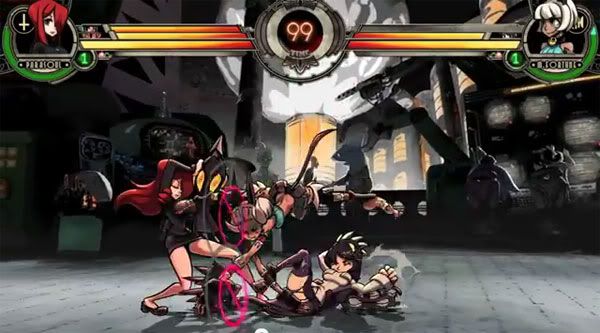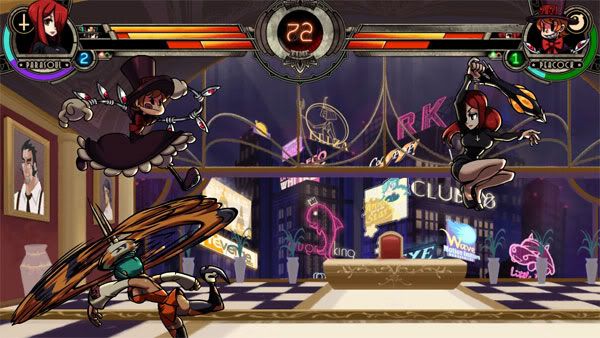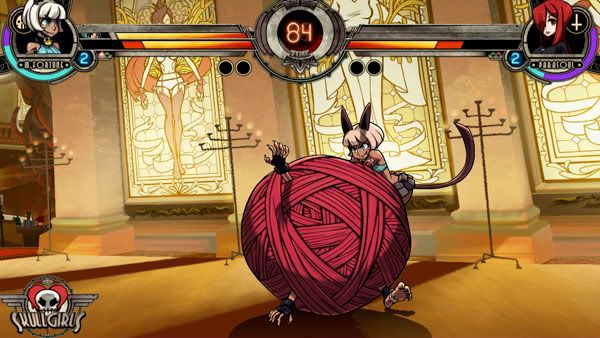This post has not been edited by the GamesBeat staff. Opinions by GamesBeat community writers do not necessarily reflect those of the staff.
As I played a preview build of Skullgirls, a team-based fighter, I couldn't do anything but block. A training challenge in the game was trying to teach me how to defend myself by getting rid of any moves that I may distract myself with. The thought process of the developers at Reverge Labs must’ve been: "If people can’t learn to guard themselves, we’ll take away all other options!"
I passed the challenge but not without learning a little something about Skullgirls. It’s not just a niche title for the hardcore fighting fan. The developers actually catered it more to casual gamers than do developers of popular franchises such as Street Fighter.
[youtube http://www.youtube.com/watch?v=PaM65D7Shjw]
After playing for roughly two hours, I noticed four features that the game has that people may want to take note of before brushing the game off as another combo-heavy, fan-service fighter.
The training mode
A standard for fighters is to have a training stage that places you in a room to practice moves. Some games, like Street Fighter 4, include challenges that try to teach you how to do a 10-hit combo. I can't recall a single title, though, that explains when to use what you’ve learned. Tekken 6, Mortal Kombat, Marvel vs Capcom 3, and others all show you the moves but not the mindset of how to be a great fighter. When is it a good chance to use an anti-air attack? Why not just block instead? What's wrong with a constant assault?
Learning answers to questions like these can help anyone improve, and Skullgirls' meticulous, goal-based training mode will try to inform you. Players who want to get better but can’t seem to grasp the genre’s mechanics besides jumping in and attacking will have a chance to learn everything from the ground up.

I experienced one of these lessons during a preview. Instead of showing me how to do a relentless 8-hit barrage, Skullgirls taught me a very basic concept, the mix-up, and how to deal with it. I wasn't learning how to play the game but how to play the genre. If you're not good at fighters but want to be, then do yourself a favor and purchase Skullgirls.
The ratio system
Skullgirls allows you to pick up to three characters to use, but it uses the ratio system. You can only start a match once you've allocated your three points. Every character can be worth one, two, or three of these. If you stick with a solitary girl, she'll have more health and stronger attacks. Grab all three for more strategy but weaker stats. Capcom vs. SNK used something similar, but it assigned predetermined ratios, i.e., Ryu would always count as two people and players could only pair him with a fighter who counted as one.
Players who love the tactics of switching characters mid-match as well as those who like to master a single hero will be happy to find this game meets their needs. They could find the title to be unique in that it allows more variety with its 3-on-1 and 2-on-1 battles.

Animations
Many animation students from the university I attended are interested in Skullgirls…not so much for the battles but for the incredibly detailed art. The game’s artists drew every frame at twice the resolution usually shown on 720p screens. This combined with real-time lighting effects and backgrounds that shake when players smash the floor make for an entertaining visual experience.
[youtube http://www.youtube.com/watch?v=nEmSeZLa0Io]
The artists' creativity and attention to detail with their roster is worth mentioning. Peacock, a '20s-era cartoon character, fries an ant on the ground with her magnifying glass instead of a traditional low kick. Filia, a girl with a parasite on her head, has a move that resembles The Little Mermaid's Ariel's hair swing complete with water flying through the air.
Then we have Ms. Fortune, an undead feline feral, who’s the most animated of the cast. She shoots blood out of her calves to dash, uses her muscle tissue to wrap foes in a "yarn" ball, and throws her head on the floor in hopes of it biting her enemies.

These details in the animations are a pleasure to watch and could inspire many young artists to push their boundaries.
Michiru Yamane's music
The soundtrack may sound familiar to hardcore Castlevania fans and not without good reason. Michiru Yamane, famous for composing the music for nearly every major Castlevania title, has contributed to Skullgirls’ soundtrack. The songs are a departure from her usual Dracula-inspired theme, so devotees of the musician who want to hear something new from her may want to give them a listen. What better way to experience her music than to battle on the stages she created them for!
[youtube http://www.youtube.com/watch?v=P0KoKdiUuOg]
Is Skullgirls for you? If you found one of the listed features to be enticing, then this could be the game to lure you into the world of fighters.
